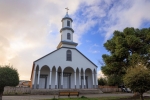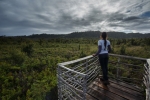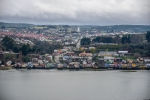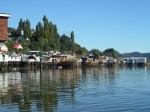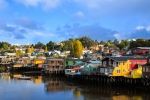Information about Chiloe
GEOGRAPHICAL CONTEXT
The archipelago of Chiloé is like a small continent attached to the Chilean territory of which it is geographically very different. Being the Great Island of Chiloé the second largest in South America; after Tierra del Fuego, it is separated from the mainland by the Chacao channel and the Andean mountain range by an inland sea, extending for more than one hundred miles to the south. The Big Island has an abrupt and inhospitable western coast, presenting throughout its coastline the eroded relief of the thousand-year-old mountain range of the coast.
This mountain range, which does not exceed one thousand meters, is drastically cut by two lakes, the Cucao and the Huillinco, and although farther south it rises again, it does not manage to recover its vertebral unit, also changing its name to the Piuchue mountain range in its northern section and Pirulil to the south. Apart from these promontories covered with impenetrable forests, the relief of the Big Island is softer than rugged.
The Big Island of Chiloé is separated from the mainland by an inland sea, divided by groups of transversal islands aligned from east to west. This inner sea forms the heart of the Reloncaví, the Gulf of Ancud and the Gulf of Corcovado.
Although to the west the island faces the fearsome Pacific Ocean, towards the east the relief unfolds in the form of gentle hills. Hills that transform pastures, meadows and bushes that extend to the same waters of the channels of the inland sea. Along this inner coast there is an exuberant landscape of green ferns, quiscales, pajonales, pangales and dozens of coves and estuaries.
The islands that make up the archipelago start in the north with the island Cacahué and end in the south with the island Talcán of the Desertores group. Gathered in schools, they form well-defined groups: On the north, adjoining the Gulf of Ancud, the Chauques group emerges, composed of the islands of Cola, Buta, Chauques, Voigue, Tauculón, Mechuque, Añihué and other minor islands. . A little more to the south and almost in the center of the Big Island appears a second group presided by the great island Quinchao, and seconded by the islands Linín, Llingua, Teuquelín, Meulín, Tac, Quenac and Caguach.
To the southwest of the island of Quinchao a third group is ordained, being the greater island, the one of Lemuy, unfolding itself towards the east the group with the islands Chelín, Quehui, Chaulinec, Alao and Apiao. After this set the Desertores group is presented, integrated by the Chulín islands, Talcán, and numerous smaller islands. Apart from these four groups of islands, the one that is located south of Queilén and at the entrance of the Compu estuary, formed for the islands Tranqui, Acuy and Chaullín. And finally the one that protects the port of Quellón with its small islands Caillín, Laitec and Codita. If you add the island of San Pedro that is at the southern tip of the big island, you get a total of 23 islands of some importance considering surface and population. In addition, you have to consider an infinity of islets, almost all inhabited, which duplicate this number. To complete this geographical panorama, it is necessary to highlight the Andean, forested and stony continental curtain that raises its snowy peaks, such as Calbuco, Corcovado, Hornopirén and other volcanoes, and that constitutes the so-called Continental Chiloe.
CHILEAN TRADITIONS AND COSTS
Within the various traditions and customs typical of the Chiloé area we can find:
I. Gastronomics
a) Curanto: One of the preparations that is made with greater care, is the characteristic dish of the area, the curanto.
The preparation of this dish is more than a recipe because it is a party in which everyone works according to it.
Mainly its confection begins with making a hole in the earth of more or less half a meter, in which large hot stones are placed, then a series of foods such as seafood (cholgas, clams, mussels, picorocos) are placed, as well as meats (sausages, chicken, smoked pork) all this is previously seasoned, should be near the stones to achieve better cooking. Finally the potatoes, chapaleles, milcaos are placed and top with nalcas leaves and a cover of champas (pieces of earth with pasture) and the pasture must be downwards, leaving to cook to the steam approximately by space of one hour.
This curanto, when serving, is accompanied by a pebre that consists of salt, water, chives, chili, cilantro, parsley and others.
b) Milcaos:
It is made with grated potatoes, which are previously crushed until the scratches are quite dry, it is joined to another quantity of cooked, ground potatoes. A dough is formed to which salt and butter are added. To make it even more tasty, add a portion of the inevitable pork rinds. Its cooking can be baked or in hot butter.
c) Chapaleles:
Dough made from raw flour that is cooked in water in the form of square sopaipilla. It is served with honey. And for the curanto, in addition to the flour, a part of potatoes
II. Traditions
La maja: It is a job involving young and strong men. It consists of grinding apples so that later they are pressed extracting the juice to them, that soon will be the famous chicha of apple.
The Medán: It is a way to provide certain goods or food that a family requires, which offers a series of invitations for a meal
with abundant liquors. Each guest already knows what to bring. There are different kinds of "medanes" according to the need of the owner of the house, of chickens, lambs, potatoes,
wheat or artifacts.
In the Medán a series of poetic songs and recitations are made related to the presentations, greetings and welcome by the homeowner and his guests.
The minga: When a family must move to an island, they usually take their house. To this effect, a number of people gather, dragging the house to the sea with oxen. Then this one, which floats like a raft because it is made of wood, is taken to its new place of destination, usually another island, and settled where it is decided.
These traditions are still maintained in Chiloé. This allows us to outline the great sense of solidarity that characterizes the Chilote and, at the same time, the rich musical and poetic tradition that accompanies it.
